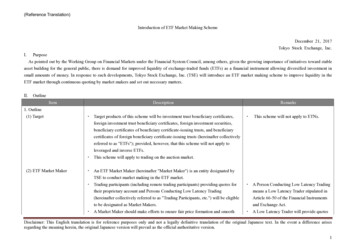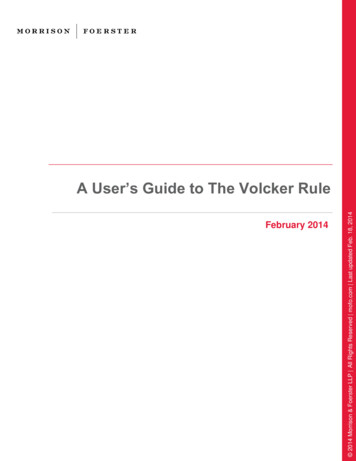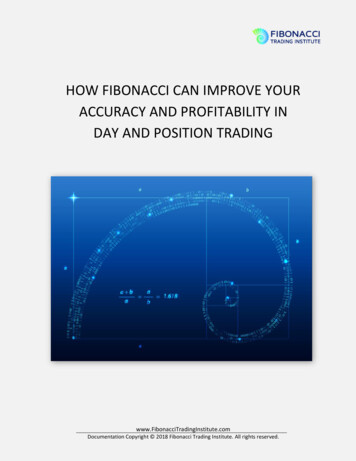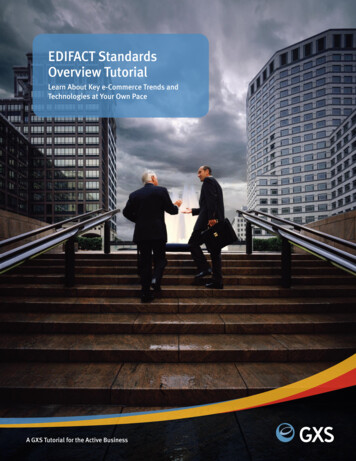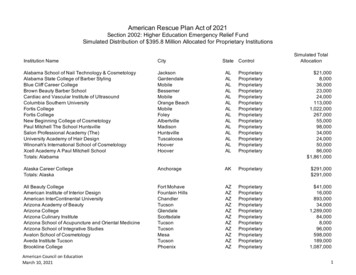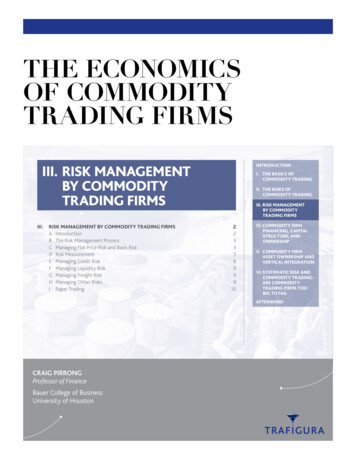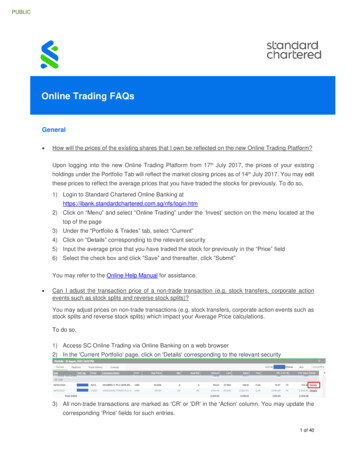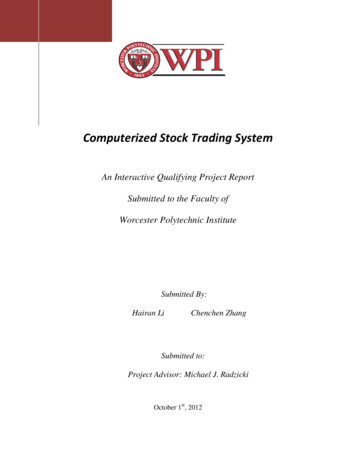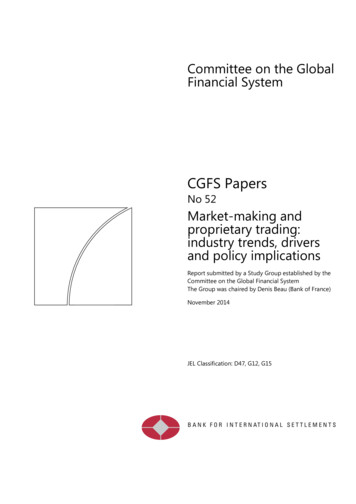
Transcription
Committee on the GlobalFinancial SystemCGFS PapersNo 52Market-making andproprietary trading:industry trends, driversand policy implicationsReport submitted by a Study Group established by theCommittee on the Global Financial SystemThe Group was chaired by Denis Beau (Bank of France)November 2014JEL Classification: D47, G12, G15
This publication is available on the BIS website (www.bis.org). Bank for International Settlements 2014. All rights reserved. Brief excerpts may bereproduced or translated provided the source is stated.ISBN 978-92-9131-995-4 (print)ISBN 978-92-9131-996-1 (online)
PrefaceMarket-makers serve a crucial role in financial markets by providing liquidity tofacilitate market efficiency and functioning. Post crisis, several developmentssuggest that the behaviour of these liquidity providers may change. Such changesand their potential impact on fixed income markets are of particular interest topolicymakers, given the relevance of these markets to monetary policy and financialstability.Against this background, in September 2013, the Committee on the GlobalFinancial System (CGFS) established a Study Group on market-making andproprietary trading (chaired by Denis Beau, Bank of France) to facilitate a betterunderstanding of how ongoing changes in these activities may affect the provisionof immediacy services and, hence, liquidity in fixed income markets.This report presents the Group’s findings. It identifies signs of increasedliquidity bifurcation and fragility, with market activity concentrating in the mostliquid instruments and deteriorating in the less liquid ones. Drivers are bothconjunctural and structural in nature, and it remains difficult at this stage to providea definitive overall assessment. Yet, given signs that liquidity risks were broadlyunderpriced in the run-up to the financial crisis, it seems likely that the compressedpricing of immediacy services observed in the past will give way to liquidity premiamore consistent with actual market-making capacity and costs. The report outlines anumber of possible policy implications that, if pursued, would help making thisoutcome more likely and would support the robustness of market liquidity.I hope that the report, and the trends and drivers described therein, will proveto be an important contribution to ongoing discussions about the changing natureof the market-making industry as well as a valuable resource for policymakers andmarket practitioners interested in the broader implications of these changes.William C DudleyChairman, Committee on the Global Financial SystemPresident, Federal Reserve Bank of New YorkMarket-making and proprietary trading: industry trends, drivers and policy implicationsiii
ContentsExecutive summary . 11. Introduction . 42. The economics of market-making . 42.1 The role of market-makers in bond markets . 52.2 The provision of market-making services . 62.3 Market-making versus proprietary trading . 93. Trends in market-making and proprietary trading . 113.1 Assessing trends in bond market liquidity . 113.2 Supply of immediacy services . 163.3 Demand for immediacy services . 193.4 Movement towards electronic trading . 214. Drivers of the observed trends . 234.1 Market-driven adjustments to market-making services. 244.2 Regulatory changes and their potential effects . 265. Market implications . 295.1 Cost of trading and issuing debt . 295.2 Market liquidity and robustness . 306. Policy implications. 356.1 Assessing liquidity risks and enhancing market robustness . 366.2 Possible backstop options . 38References . 41Appendix 1: Study Group mandate . 45Appendix 2: Overview of regulatory definitions. 47Appendix 3: Measuring trends in market-making and proprietary trading. 52Appendix 4: Surveying market-makers on the expected impact of regulation . 54Members of the Study Group. 57Market-making and proprietary trading: industry trends, drivers and policy implicationsv
Executive summaryMarket-makers serve a crucial role in financial markets by providing liquidity tofacilitate market efficiency and functioning. Changes in the behaviour of marketmakers as well as other liquidity providers and their impact on liquidity in fixedincome markets are of particular interest to policymakers, given the relevance ofthese markets to monetary policy and financial stability. This report studies currenttrends and drivers that determine these behaviours before going on to assess theirimplications for market functioning and robustness. The main findings are:Observed trends in market liquidity conditionsDiverging liquidity trends. Market liquidity in most sovereign bond markets hasreturned to levels comparable to those before the global financial crisis, assuggested by a variety of metrics and feedback from market participants. There are,however, signs of increased liquidity bifurcation and fragility, with market activityconcentrating in the most liquid instruments and deteriorating in the less liquidones, such as corporate bonds.These signs reflect changes under way in market-making supply and demand,which are following diverging paths, prompting market participants to seek ways tolimit any impact on trading costs and market liquidity.Decline in dealer risk-taking capacity and/or willingness. One apparenttrend is market-makers’ increasing focus on activities requiring less capital andbalance sheet capacity. In line with this development, banks in many jurisdictionsreport allocating less capital to their market-making activities and are reducing theirinventories by cutting back on their holdings of, in particular, less liquid assets.Increasing differentiation and greater focus on core markets. A number ofmarket-makers have reportedly adopted a more selective approach to offeringclient services (eg focusing on core clients), whereas others are narrowing the scopeof their services (eg focusing on a smaller range of markets). In many jurisdictions,market-making has been shifting towards a more order-driven and/or brokeragemodel. As a result, the execution of large trades tends to require more time, withmany market-makers being more reluctant to absorb large positions.Diminishing proprietary trading by banks. Proprietary trading has reportedlydiminished or assumed more marginal importance for banks in most jurisdictions,particularly in the euro area. Expectations are for banks’ proprietary trading togenerally decline further or to be shifted to less regulated entities in response toregulatory reforms targeting these activities. This contrasts with trends in individualjurisdictions, particularly in Asia, that have been less affected by the recent crisis.Growing and more concentrated demand for immediacy services. Primarybond market expansion amid significant flows of funds to market participants thatrequire immediacy services point to growing demand for market-making. There arealso signs of increasing concentration among market participants that demandimmediacy services, such as asset managers. As a result, market liquidity couldbecome more dependent on the portfolio allocation decisions of only a few largeinstitutions.Market-making and proprietary trading: industry trends, drivers and policy implications1
In addition, some market players have become more exposed to changes in theavailability of market-making services. For one, bond funds that promise “daily”liquidity have grown significantly in past years, amid incentives to invest in lessliquid instruments in a low-yield environment. Yet, given reduced immediacyprovision by dealers, liquidating these assets could prove more difficult thanexpected when market sentiment deteriorates.Adjustment in trade execution. Portfolio managers are adjusting the way theyexecute their trades to the changing costs and availability of immediacy services.Some are increasingly exploring trading strategies that split transactions intosmaller amounts or use other means to optimise trading performance. While theseadjustments would tend to mitigate the effects of rising demand for immediacyservices, the associated costs (eg for IT infrastructure investments) may be difficultto bear for smaller firms.Expansion of electronic trading. The use of electronic trading in bondmarkets has been growing, although from relatively low levels, with marketparticipants seeking more price transparency and cheaper trade execution. Tradingplatforms (if not single dealer-based) tend to support market functioning bypooling liquidity from multiple dealers. That said, existing electronic platforms areoften used only for a limited range of typically standardised and smaller-sizedtransactions, and they often remain dependent on the provision of immediacyservices by the same entities that otherwise provide liquidity outside of theseplatforms.Drivers and implicationsBoth market-based and regulatory drivers. The available evidence suggests thatobserved trends are the result of a broader post-crisis response, raising questionsabout the extent to which these trends will be cyclical or structural in nature. Givenrecent crisis experiences, market participants from various jurisdictions underscorethe decline in dealers’ risk tolerance as one major driver of the reduction in marketmaking. Market-makers in many jurisdictions are thus raising the risk premia theydemand, reassessing their risk management frameworks and developing moregranular assessments of the value of trades, driving up the cost of taking risk.The post-crisis response also includes regulatory change that has been initiatedto reduce systemic risks in the financial system, including in terms of strengtheningthe balance sheets and funding models of key market-making institutions. Theseimprovements will reduce the probability of banks becoming a source of illiquiditycontagion and can contribute to more robust market-making. However, manymarket participants also expect ongoing changes in regulation to raise the cost ofproviding immediacy services during normal times, potentially reinforcing theobserved trend towards liquidity bifurcation – although to different degrees acrossasset classes and jurisdictions.Market implications. Diverging trends for market-making supply and demandgenerally imply upward pressure on trading costs, reduced market liquidity insecondary markets and, potentially, higher costs of financing in primary markets. Atthe same time, the compressed pricing of immediacy services observed before theglobal financial crisis will likely give way to liquidity premia more consistent withactual market-making capacity and costs.2Market-making and proprietary trading: industry trends, drivers and policy implications
At this stage, there is no conclusive evidence of a widespread rise in tradingcosts, as a number of factors may be containing the pass-through to clients andissuers. Yet, liquidity may become increasingly fragile in some market segments asthe above trends and drivers may have raised the probability of an adverse impactof large and self-reinforcing order imbalances on liquidity conditions – particularlyin the current environment of low policy rates and compressed term premia.Policy implications. Policy responses to these developments can becategorised in terms of (i) supporting initiatives to raise the probability of achievingmore appropriately priced and robust liquidity conditions; and (ii) possible backstopsto address vulnerabilities that may arise under adverse scenarios.On the subject of supporting initiatives, first, market participants and relevantauthorities should help mitigate the risks associated with liquidity illusion bystrengthening liquidity risk management as well as by improving markettransparency and monitoring. With the cumulative effects of the newly emergingregulatory environment and other structural changes still uncertain, policymakersmay also want to keep track of their combined impact on the effectiveness androbustness of market-making arrangements.Second, market-making institutions and their supervisors should ensure thatimprovements to shock absorption capacities brought about by ongoing regulatoryreforms are effective in stressed liquidity conditions, for example via dedicatedliquidity stress tests devised for that purpose.Third, where appropriate, sovereign issuers may want to establish new or reviewand expand existing incentive schemes for market-makers to enhance secondarymarket liquidity, while private debt issuers should assess and exploit any potentialfor greater standardisation of their issuance practices.In terms of possible backstops, regular liquidity-providing activities are likely toremain central banks’ main line of defence. Establishing or expanding securitieslending facilities could be considered as an additional option to improve, as needed,market liquidity in key markets during times of stress and to support the robustnessof the associated repo markets. Considering other, more direct measures to supportmarket functioning involves several difficult cost-benefit trade-offs (eg due to therisk of distorting economic incentives for market participants). These would need tobe taken into account by policymakers if they were to consider whether and underwhat conditions they might be prepared to adjust existing backstops in the future.Market-making and proprietary trading: industry trends, drivers and policy implications3
1. IntroductionMarket liquidity – the ability to rapidly execute large financial transactions with alimited price impact – is a key feature of financial market efficiency and functioning.1Monitoring and ensuring liquidity in fixed income markets is of particular interest tocentral banks and other authorities, given the relevance of these markets tomonetary policy and financial stability.2As witnessed during past episodes of financial market turmoil, however, marketliquidity can evaporate quickly. Assessing the robustness of financial markets thusrequires an analysis of the factors that determine the behaviour of liquidityproviders and seekers. For sovereign and, to an even greater degree, corporatebond markets, liquidity hinges in large part on the capacity and willingness ofmarket-makers and, to some extent, proprietary traders to absorb temporarydemand-supply imbalances by taking on inventory risk. Post-crisis, severaldevelopments suggest that the behaviour of these liquidity providers may besubject to change, which is why the Committee on the Global Financial System(CGFS) decided to establish a Study Group to investigate these developments andassess their implications for policymakers.3This report lays out the Group’s findings, starting with a conceptual frameworkof the economics of market-making (Section 2) that is used to structure the analysisof trends (Section 3) and drivers (Section 4) in market-making and proprietarytrading in sovereign and corporate bond markets. Based on the findings of thisanalysis, the report highlights key implications for market functioning androbustness (Section 5) before going on to discuss a number of policy implications(Section 6).The views expressed in this report rest on, and are constrained by, an analysisof the data that is currently available to central banks and a review of the literature.The Group’s views have also been informed by an informal survey and a series ofinterviews with private sector experts representing market-making institutions aswell as institutional investors in the Group members’ home jurisdictions.2. The economics of market-makingThis section presents a stylised framework of the economics of market-making tohelp structure the discussion of trends and drivers in market-making andproprietary trading that is presented in the following sections. It starts with anassessment of the role of market-makers in sovereign and corporate bond markets.This is followed by a discussion of how market-makers provide immediacy servicesand of how market-making differs from proprietary trading.1See CGFS (1999) for a discussion of the definition of market liquidity and its different dimensions(eg tightness, depth and resiliency).2A discussion of the link between financial stability and bond markets is presented in CGFS (2007).3A list of the Study Group members is attached at the end of this report; Appendix 1 states the StudyGroup’s mandate.4Market-making and proprietary trading: industry trends, drivers and policy implications
2.1 The role of market-makers in bond marketsThe vast majority of bonds are traded over the counter (OTC) rather than on thecentral limit order books of exchanges. The dominance of the OTC market structurereflects a number of bond market characteristics, such as: (i) the large number ofissued bonds, which reduces the probability of finding matches in investor supplyand demand for any given bond;4 (ii) the fixed maturity of bonds, allowing buy andhold investors to recoup their invested funds without trading in secondary markets,often resulting in ever fewer trades towards the bond’s date of maturity; and (iii) theprevalence of institutional investors who require execution of large-volumetransactions that could potentially have a strong price impact when trading on afully disclosed central limit order book.5In the absence of continuous two-way markets for buyers and sellers, brokerdealers, such as banks and securities trading firms, facilitate bond transactions. Theyeither fulfil client orders by finding matches in existing supply and demand(brokerage or agency trading) or step in as the counterparty of their clients’ tradesby committing their own balance sheet capacity (market-making or principaltrading; see discussion below). Therefore, market-makers:(i)provide immediacy services to clients and other market participants,ensuring market liquidity and supporting price discovery;6(ii)contribute to the robustness of market liquidity by absorbing temporarysupply and demand imbalances, dampening the impact of shocks onmarket volatility and quoting prices to support investors in valuing assets.7Primary and secondary bond markets are closely related, with many marketmaking firms active in both. Bond issuers generally have an incentive to improve theliquidity of their issues in secondary markets to reduce the premium that investorsdemand.8 Many jurisdictions have thus adopted primary dealer (PD) systems forcentral government bonds that often combine incentive schemes with marketmaking obligations (Box 1).Other frequent issuers, such as regional governments, government-sponsoredenterprises or supranational institutions, have similar (but usually less formal)setups. This contrasts with infrequent issuers, such as the majority of corporates,where dealers are more likely to support secondary market liquidity for a fee on adeal by deal basis or in return for underwriting deals and other related businesswith the corporate issuer.4According to the International Capital Market Association (ICMA), 6,810 shares were admitted totrading on regulated markets in the EU in July 2009 as compared with the more than 150,000 debtsecurities contained in Xtrakter’s Computer Updated International Database (CUPID).5Biais and Green (2007), for example, document how the rising importance of institutional investorscoincided with a shift in trading of US municipal and corporate bonds from the New York StockExchange (NYSE) to OTC markets in the late 1920s and mid-1940s, respectively.6In general terms, immediacy services include all services provided by intermediaries (eg dealers,brokers) that support market participants in executing their trades on an immediate basis.7For the purpose of this report, market liquidity is considered robust if it proves sufficientlyinsensitive to adverse shocks on the underlying financial market.8Sovereign bond issuers may also want to promote the liquidity of their bonds as part of a broadereffort to develop domestic financial markets.Market-making and proprietary trading: industry trends, drivers and policy implications5
Box 1Market-making by primary dealers in sovereign bond marketsIn many jurisdictions, access to the primary central government debt market is restricted to primary (or “authorised”)dealers (PDs). PDs are appointed by the sovereign issuer or its agent to buy, promote and distribute sovereign debtsecurities. In addition (typically) to preferential access to sovereign debt auctions, they often benefit from otherprivileges such as (i) eligibility to participate in non-competitive auctions; (ii) access to the fiscal agent’s or centralbank’s securities lending facilities; or (iii) being considered by the agent as a privileged counterparty for debtmanagement operations (eg syndicated issuance, buybacks, swaps).In turn, PDs in many countries are obliged to meet specific requirements in the primary market, often includingquantitative thresholds for auction participation, as well as market-making obligations in secondary markets. Theseobligations differ across jurisdictions, with some requiring PDs to continuously quote firm two-way prices, includinglimits on bid-ask spreads and minimum amounts of quoted volumes, whereas others provide more leeway to PDs inadjusting their quotes.Large banking groups tend to have many PD mandates, reinforcing the close ties between primary andsecondary sovereign bond markets. Yet, interviews with market participants suggest that many dealers have beenconcentrating their efforts on a reduced number of core market segments, even though the incentives offered toPDs tend to be more generous for smaller, less liquid sovereign bond markets. This could affect secondary marketliquidity in those markets where the remaining PDs lack the capacity to take up the market share. According, for example, to the Association for Financial Markets in Europe (AFME), 10 banks had 10 or more PD mandates in nationalEuropean bond markets in September 2013. One example is Sweden, where the debt management office pays commissions to PDs for participating in primary and secondarysovereign bond markets.2.2 The provision of market-making servicesWhile the business models of market-makers differ depending on, for example, themarket segments in which they operate, they broadly share a number of commonfeatures. These include: a sufficiently large client base to ensure access to sizeableorder flow information; the balance sheet capacity to take on large principalpositions; continuous access to multiple markets, including those for funding andhedging instruments; the capacity to manage inventory and other risks; and marketexpertise to provide competitive quotes, including during times of elevated financialmarket volatility. Graph 1 provides a stylised overview of the resulting interlinkagesbased on the example of a bank’s bond market-making desk.9A simplified market-maker’s profit and loss (P&L) account highlights how theseinterlinkages map into revenues and costs (Graph 2). Two broad categories of (net)revenues can be defined: first, facilitation revenues, which reflect the realised spreadon the bid and ask prices, net of the cost of trading. Second, unless trades can beimmediately offset by opposing trades (ie the market-maker matches existingorders so that inventories remain unaffected) the P&L account is complemented byinventory revenues. These comprise changes in the value of the warehoused asset,carry of the position (eg accrued interest), the cost of funding as well as hedging96Some papers in the literature also link market-making activities to dealers’ research coverage,suggesting that dealers make markets in securities where they have built up an informationaladvantage. For studies on US equities see, for example, Madureira and Underwood (2008) orSchultz (2003).Market-making and proprietary trading: industry trends, drivers and policy implications
costs. Regulatory requirements and similar constraints are another important factor.They affect market-makers’ P&L along various dimensions, including via theirimpact on capital, funding and hedging costs, and central clearing incentives as wellas other costs (eg compliance).Quoted bid-ask spreads thus incorporate market-makers’ expectations of thecost and risk associated with a change in inventory.10 Therefore, bid-ask spreads willtend to be narrow (and quoted quantities high) if trading positions can be offsetquickly and at low cost or if the cost of funding inventory is low. The liquidity of agiven market hence also depends on the functioning and liquidity of relatedmarkets that facilitate the management of risks (eg derivatives markets for hedging,inter-dealer markets for redistribution of inventory) as well as those that are usedfor funding (eg repo).Market-making – in-house and market-related interlinkagesGraph 1Source: CGFS Study Group.10For an overview of theoretical and empirical studies on market-makers’ quoting strategies seeMadhavan (2000).Market-making and proprietary trading: industry trends, drivers and policy implications7
Market-maker’s profit and loss (P&L) account1Graph 2Other costs include, for example, trading desk and support staff, compliance, IT and administrative costs as well as central counterpartymembership fees. Other revenues may include income from other business lines (eg syndication) that is attributed to the market-makingdesk.Source: CGFS Study Group.Another factor affecting quotes at the individual dealer level is the differencebetween the current and the desired inventory. The latter reflects current andexpected customer order flows as well as limits imposed by the dealer’s riskmanagement framework (Graph 1), eg those based on value-at-risk (VaR) and othermetrics.11 Dealers whose positions approach the limits set by their institution’s riskmanagement framework are thus incentivised to adjust their quotes to realign theirinventory. Reduced tolerance for risk at the firm level will impact the amount ofcapital dedicated to market-making activities. This is likely to affect less liquidmarkets most, as these typically require market-makers to warehouse securities forlonger periods of time with fewer hedging options, driving up inventory risks.The market structure, including the way quotes are provided, may also have abearing on and be indicative of a market’s liquidity. The prevailing structure in bond11Interviews with market participants suggest that risk metrics have been refined in recent years tobetter reflect the specific risks of the underlying financial instrument. VaR limits remain the mostcommonly used tool, followed by metrics such as delta risk and limits on the exposure to yieldchanges (eg based on duration measures, such as DV01). Stressed VaR and limits on issuerexposures have also gained importance. Likewise, stress testing of portfolios and internal capitalcharges that incentivise higher inventory turnover have become increasingly popular as well.8Market-making and proprietary trading: industry trends, drivers and policy implications
markets features competing dealers. Quotes are transmitted to clients or otherdealers (eg on inter-dealer markets) either directly (eg by voice or displayed on thescreen of electronic platforms) or via brokers who facilitate trades for a commission(Graph 1). In the most liquid markets, such as those for sovereign bonds, two-wayprices are continuously provided (ie quote-driven markets). Bid-ask spreads in thesemarkets are typically tight. Profit margins for market-making are thus thin, requiringmarket-makers to seek high inventory turnover. Given that continuous access tofirm (ie readily executable) two-way prices facilitates trading and promotes marketliquidity, a number of sovereign issuers (Box 1) and trading venues offer incentivesfor market participants to take on market-making obligations.12 Less liquid markets,in contrast, will tend to be order-driven. In these markets, clients request quotesfrom market-makers and thus do not have access to firm prices on an on
Expansion of electronic trading. The use of electronic trading in bond markets has been growing, although from relatively low levels, with market participants seeking more price transparency and cheaper trade execution. Trading platforms (if not single dealer-based) tend to support market functioning by pooling liquidity from multiple dealers.
